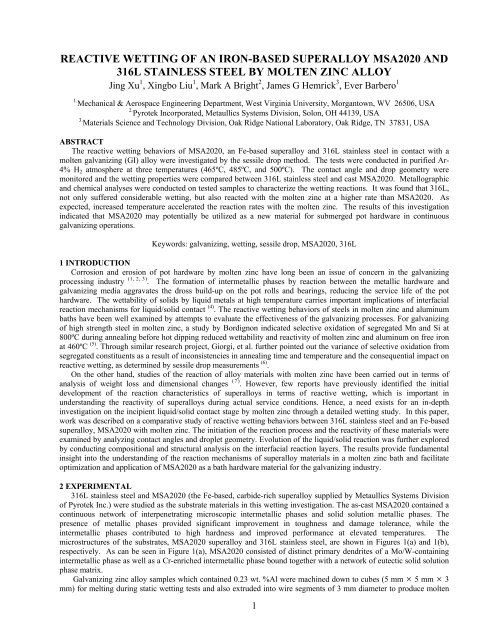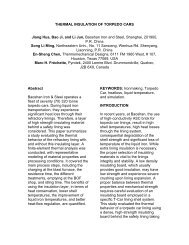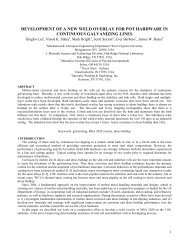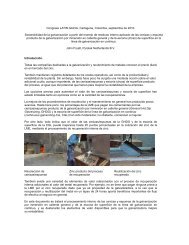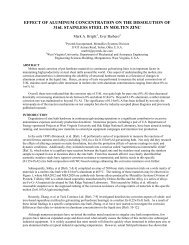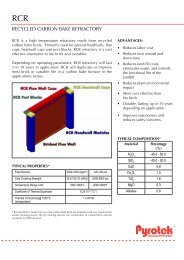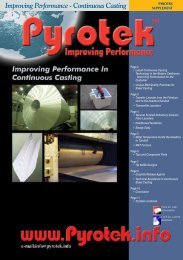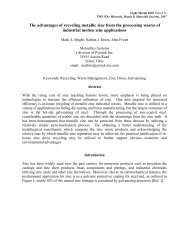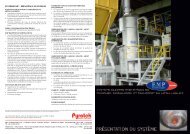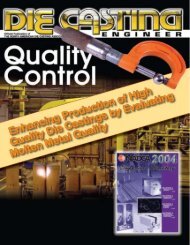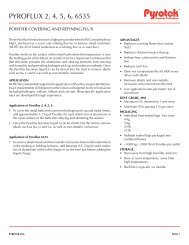Reactive Wetting of an Iron-Based Superalloy MSA2020 ... - Pyrotek
Reactive Wetting of an Iron-Based Superalloy MSA2020 ... - Pyrotek
Reactive Wetting of an Iron-Based Superalloy MSA2020 ... - Pyrotek
Create successful ePaper yourself
Turn your PDF publications into a flip-book with our unique Google optimized e-Paper software.
REACTIVE WETTING OF AN IRON-BASED SUPERALLOY <strong>MSA2020</strong> AND<br />
316L STAINLESS STEEL BY MOLTEN ZINC ALLOY<br />
Jing Xu 1 , Xingbo Liu 1 , Mark A Bright 2 , James G Hemrick 3 , Ever Barbero 1<br />
1. Mech<strong>an</strong>ical & Aerospace Engineering Department, West Virginia University, Morg<strong>an</strong>town, WV 26506, USA<br />
2. <strong>Pyrotek</strong> Incorporated, Metaullics Systems Division, Solon, OH 44139, USA<br />
3. Materials Science <strong>an</strong>d Technology Division, Oak Ridge National Laboratory, Oak Ridge, TN 37831, USA<br />
ABSTRACT<br />
The reactive wetting behaviors <strong>of</strong> <strong>MSA2020</strong>, <strong>an</strong> Fe-based superalloy <strong>an</strong>d 316L stainless steel in contact with a<br />
molten galv<strong>an</strong>izing (GI) alloy were investigated by the sessile drop method. The tests were conducted in purified Ar-<br />
4% H2 atmosphere at three temperatures (465ºC, 485ºC, <strong>an</strong>d 500ºC). The contact <strong>an</strong>gle <strong>an</strong>d drop geometry were<br />
monitored <strong>an</strong>d the wetting properties were compared between 316L stainless steel <strong>an</strong>d cast <strong>MSA2020</strong>. Metallographic<br />
<strong>an</strong>d chemical <strong>an</strong>alyses were conducted on tested samples to characterize the wetting reactions. It was found that 316L,<br />
not only suffered considerable wetting, but also reacted with the molten zinc at a higher rate th<strong>an</strong> <strong>MSA2020</strong>. As<br />
expected, increased temperature accelerated the reaction rates with the molten zinc. The results <strong>of</strong> this investigation<br />
indicated that <strong>MSA2020</strong> may potentially be utilized as a new material for submerged pot hardware in continuous<br />
galv<strong>an</strong>izing operations.<br />
Keywords: galv<strong>an</strong>izing, wetting, sessile drop, <strong>MSA2020</strong>, 316L<br />
1 INTRODUCTION<br />
Corrosion <strong>an</strong>d erosion <strong>of</strong> pot hardware by molten zinc have long been <strong>an</strong> issue <strong>of</strong> concern in the galv<strong>an</strong>izing<br />
processing industry (1, 2, 3) . The formation <strong>of</strong> intermetallic phases by reaction between the metallic hardware <strong>an</strong>d<br />
galv<strong>an</strong>izing media aggravates the dross build-up on the pot rolls <strong>an</strong>d bearings, reducing the service life <strong>of</strong> the pot<br />
hardware. The wettability <strong>of</strong> solids by liquid metals at high temperature carries import<strong>an</strong>t implications <strong>of</strong> interfacial<br />
reaction mech<strong>an</strong>isms for liquid/solid contact (4) . The reactive wetting behaviors <strong>of</strong> steels in molten zinc <strong>an</strong>d aluminum<br />
baths have been well examined by attempts to evaluate the effectiveness <strong>of</strong> the galv<strong>an</strong>izing processes. For galv<strong>an</strong>izing<br />
<strong>of</strong> high strength steel in molten zinc, a study by Bordignon indicated selective oxidation <strong>of</strong> segregated Mn <strong>an</strong>d Si at<br />
800ºC during <strong>an</strong>nealing before hot dipping reduced wettability <strong>an</strong>d reactivity <strong>of</strong> molten zinc <strong>an</strong>d aluminum on free iron<br />
at 460ºC (5) . Through similar research project, Giorgi, et al. further pointed out the vari<strong>an</strong>ce <strong>of</strong> selective oxidation from<br />
segregated constituents as a result <strong>of</strong> inconsistencies in <strong>an</strong>nealing time <strong>an</strong>d temperature <strong>an</strong>d the consequential impact on<br />
reactive wetting, as determined by sessile drop measurements (6) .<br />
On the other h<strong>an</strong>d, studies <strong>of</strong> the reaction <strong>of</strong> alloy materials with molten zinc have been carried out in terms <strong>of</strong><br />
<strong>an</strong>alysis <strong>of</strong> weight loss <strong>an</strong>d dimensional ch<strong>an</strong>ges (7) . However, few reports have previously identified the initial<br />
development <strong>of</strong> the reaction characteristics <strong>of</strong> superalloys in terms <strong>of</strong> reactive wetting, which is import<strong>an</strong>t in<br />
underst<strong>an</strong>ding the reactivity <strong>of</strong> superalloys during actual service conditions. Hence, a need exists for <strong>an</strong> in-depth<br />
investigation on the incipient liquid/solid contact stage by molten zinc through a detailed wetting study. In this paper,<br />
work was described on a comparative study <strong>of</strong> reactive wetting behaviors between 316L stainless steel <strong>an</strong>d <strong>an</strong> Fe-based<br />
superalloy, <strong>MSA2020</strong> with molten zinc. The initiation <strong>of</strong> the reaction process <strong>an</strong>d the reactivity <strong>of</strong> these materials were<br />
examined by <strong>an</strong>alyzing contact <strong>an</strong>gles <strong>an</strong>d droplet geometry. Evolution <strong>of</strong> the liquid/solid reaction was further explored<br />
by conducting compositional <strong>an</strong>d structural <strong>an</strong>alysis on the interfacial reaction layers. The results provide fundamental<br />
insight into the underst<strong>an</strong>ding <strong>of</strong> the reaction mech<strong>an</strong>isms <strong>of</strong> superalloy materials in a molten zinc bath <strong>an</strong>d facilitate<br />
optimization <strong>an</strong>d application <strong>of</strong> <strong>MSA2020</strong> as a bath hardware material for the galv<strong>an</strong>izing industry.<br />
2 EXPERIMENTAL<br />
316L stainless steel <strong>an</strong>d <strong>MSA2020</strong> (the Fe-based, carbide-rich superalloy supplied by Metaullics Systems Division<br />
<strong>of</strong> <strong>Pyrotek</strong> Inc.) were studied as the substrate materials in this wetting investigation. The as-cast <strong>MSA2020</strong> contained a<br />
continuous network <strong>of</strong> interpenetrating microscopic intermetallic phases <strong>an</strong>d solid solution metallic phases. The<br />
presence <strong>of</strong> metallic phases provided signific<strong>an</strong>t improvement in toughness <strong>an</strong>d damage toler<strong>an</strong>ce, while the<br />
intermetallic phases contributed to high hardness <strong>an</strong>d improved perform<strong>an</strong>ce at elevated temperatures. The<br />
microstructures <strong>of</strong> the substrates, <strong>MSA2020</strong> superalloy <strong>an</strong>d 316L stainless steel, are shown in Figures 1(a) <strong>an</strong>d 1(b),<br />
respectively. As c<strong>an</strong> be seen in Figure 1(a), <strong>MSA2020</strong> consisted <strong>of</strong> distinct primary dendrites <strong>of</strong> a Mo/W-containing<br />
intermetallic phase as well as a Cr-enriched intermetallic phase bound together with a network <strong>of</strong> eutectic solid solution<br />
phase matrix.<br />
Galv<strong>an</strong>izing zinc alloy samples which contained 0.23 wt. %Al were machined down to cubes (5 mm × 5 mm × 3<br />
mm) for melting during static wetting tests <strong>an</strong>d also extruded into wire segments <strong>of</strong> 3 mm diameter to produce molten<br />
1
sessile drops during dynamic testing. Experiments were carried out at various temperatures from 465°C to 500°C <strong>an</strong>d<br />
different testing duration from 1 to 4 hours.<br />
(a) (b)<br />
Figure 1: Microstructure <strong>of</strong> the tested samples:<br />
(a) <strong>MSA2020</strong> (b) 316L<br />
2<br />
Tube Furnace<br />
Quartz Metal Slug<br />
Molten Metal Drop<br />
Thermocou<br />
Sample<br />
Substra<br />
Slide<br />
Sample Holder<br />
Vacuum/Gas<br />
Inlet<br />
Figure 2: Schematic overview <strong>of</strong> the sessile drop unit<br />
Both static <strong>an</strong>d dynamic sessile drop methods were employed for studying the wettability. The apparatus used for<br />
both methods <strong>of</strong> sessile drop experiments is schematically illustrated in Figure 2 <strong>an</strong>d consisted <strong>of</strong> a 33 kW horizontal<br />
circular infrared furnace fitted with a rotary pump evacuating system <strong>an</strong>d continuous gas system. A small diameter<br />
quartz tube was also passed through the copper lid <strong>an</strong>d extended to a location directly above the sample substrate where<br />
the tube was bent 90º <strong>an</strong>d its diameter was reduced. This tube was used to contain the zinc alloy wire segment during<br />
heating <strong>an</strong>d melting which produced the molten metal drop for the dynamic tests. Both sealed end caps <strong>of</strong> the furnace<br />
assembly contained quartz windows allowing a high resolution color CCD camera to monitor the experiments. Three<br />
Type-S thermocouples (with ceramic sheath) were inserted into the horizontal quartz test chamber through the copper<br />
end-plate for monitoring <strong>of</strong> the substrate temperature, molten metal drop temperature, <strong>an</strong>d the reaction temperatures.<br />
Before each experiment, the substrate <strong>an</strong>d the zinc alloy cube (or wire segment) were ultrasonically cle<strong>an</strong>ed in<br />
acetone <strong>an</strong>d the substrate was then carefully slid into the center <strong>of</strong> the horizontal chamber. According to the static<br />
method, a cube <strong>of</strong> zinc alloy was placed on top <strong>of</strong> the substrate prior to heating. The sealed chamber was evacuated to a<br />
vacuum <strong>of</strong> 1×10 -6 Pa <strong>an</strong>d then refilled with the purified Ar-4%H2 gas. Following the gas purging, the infrared (IR)<br />
quartz chamber was heated to the required temperature. The cube <strong>of</strong> metal was allowed to melt <strong>an</strong>d the wetting behavior<br />
between the zinc alloy <strong>an</strong>d the substrate was observed.<br />
For the dynamic sessile drop method, a wire segment <strong>of</strong> zinc alloy was placed into the quartz tube used for<br />
delivering molten zinc to the substrate <strong>an</strong>d this tube was inserted through the copper end-plate into the IR chamber. The<br />
chamber was evacuated <strong>an</strong>d refilled in the same m<strong>an</strong>ner as for the static test. While the zinc segment in the quartz tube<br />
was kept at the cold zone, the IR quartz chamber was heated up to the required temperature. The furnace was allowed to<br />
stabilize for 20 minutes before the zinc segment was slowly moved from the cold zone to the hot zone <strong>of</strong> the furnace<br />
where it was allowed to melt <strong>an</strong>d pass through the vertical portion <strong>of</strong> the delivery tube as a molten drop onto the test<br />
substrate. At the end <strong>of</strong> each experiment, the substrate was removed from the furnace <strong>an</strong>d prepared for examination.<br />
Metallographic specimens <strong>of</strong> the as-received materials <strong>an</strong>d cross-sections <strong>of</strong> the tested samples were prepared following<br />
a st<strong>an</strong>dard procedure. The identification <strong>of</strong> reaction products was conducted using a JEOL 8200 Electron Probe Micro<br />
Analyzer (EPMA) with details <strong>of</strong> the reaction products in the samples examined using a HITACHI 4700 Sc<strong>an</strong>ning<br />
Electron Microscope (SEM) equipped with <strong>an</strong> integral Energy Dispersive Spectrometer (EDS).<br />
3 RESULTS<br />
3.1 <strong>Wetting</strong> <strong>an</strong>d Contact Angle<br />
Illustrating the ch<strong>an</strong>ges in contact <strong>an</strong>gle <strong>an</strong>d drop geometry with time, Figure 3 shows images <strong>of</strong> a molten zinc drop<br />
on the 316L stainless <strong>an</strong>d <strong>MSA2020</strong> substrates during isothermal dwelling at 485°C. The initial contact <strong>an</strong>gle between<br />
the 316L substrate <strong>an</strong>d liquid zinc alloy was <strong>an</strong> obtuse <strong>an</strong>gle (>90°) [Figure 3(b)], but was found to gradually decrease<br />
to <strong>an</strong> acute <strong>an</strong>gle (
MSA 2020<br />
316L<br />
MSA 2020 316L MSA 2020 316L MSA 2020<br />
316L<br />
(a) (b) (c) (d)<br />
Figure 3: <strong>Wetting</strong> <strong>of</strong> <strong>MSA2020</strong> (left) <strong>an</strong>d 316L stainless steel (right) with the Zn-0.23Al droplet at 485 ºC after<br />
(a) initial; (b) 10 minutes; (c) 30 minutes; (d) 120 minutes<br />
Four parameters, namely contact <strong>an</strong>gle (CA), drop volume (V), drop base diameter (D), <strong>an</strong>d drop height (H), were<br />
<strong>an</strong>alyzed to gain insight into the reactive wetting kinetics. The wetting kinetics could be inferred by combination <strong>of</strong> the<br />
ch<strong>an</strong>ges in contact <strong>an</strong>gle with the ch<strong>an</strong>ges in drop size. The ch<strong>an</strong>ge in contact <strong>an</strong>gle characterized by the adv<strong>an</strong>ce <strong>of</strong> the<br />
triple phase reaction (where the solid substrate, liquid metal, <strong>an</strong>d gaseous experimental environment are in contact) was<br />
due to the decrease in the drop height <strong>an</strong>d/or the increase in the drop base diameter. The determin<strong>an</strong>t factor depended on<br />
the specific wetting system. From Figure 3, it was observed that the drop volume <strong>of</strong> both 316L stainless <strong>an</strong>d <strong>MSA2020</strong><br />
continuously decreased during the wetting process, minimizing the drop volume present at the end <strong>of</strong> the wetting tests<br />
after 120 minutes. Combining the results obtained after 2 hours at both 465ºC <strong>an</strong>d 485ºC, shown in Figure 3(d) <strong>an</strong>d<br />
Figure 4(a) respectively, it was found that the decrease <strong>of</strong> the drop height was the domin<strong>an</strong>t sub-stage for the wetting <strong>of</strong><br />
<strong>MSA2020</strong>, while the increase in drop base diameter by spreading <strong>of</strong> the molten zinc overwhelmed the reactive wetting<br />
process on 316L stainless.<br />
MSA<br />
Zn<br />
2020<br />
316L<br />
(a) (b)<br />
Figure 4: <strong>MSA2020</strong> & 316L wetting after 2 hrs at 465 ºC<br />
(a) Optical view; (b) BSE <strong>of</strong> cross-sectional <strong>of</strong> 316L<br />
(a) (b) (c) (d)<br />
Figure 5: Backscatter micrographs <strong>an</strong>d electron microprobe mapping <strong>of</strong> wetting with the Zn-0.23Al droplet at 465 ºC<br />
after 4 hours (a) BSE <strong>of</strong> 316L; (b) BSE <strong>of</strong> <strong>MSA2020</strong>; (c) & (d) EPMA <strong>of</strong> <strong>MSA2020</strong><br />
At 465ºC, molten zinc did not wet the <strong>MSA2020</strong> after 2 hours, as evident by the solidified drop which easily<br />
detached from the substrate after the test without <strong>an</strong>y adhesion [Figure 4(a)]. However, when the dwelling time was<br />
extended from 2 hours to 4 hours at 465ºC, the molten zinc drop could stick onto the <strong>MSA2020</strong> surface more readily,<br />
although the contact <strong>an</strong>gle was as large as 145ºC [Figure 5(b)]. The EPMA <strong>an</strong>alysis showed that a thin Fe-aluminide<br />
layer was formed, bonding with the <strong>MSA2020</strong> substrate [Figures 5(c) & 5(d)].<br />
Increasing the heating temperature from 465ºC to 485ºC <strong>an</strong>d subsequently to 500ºC, the wetting perform<strong>an</strong>ce <strong>of</strong><br />
<strong>MSA2020</strong> was studied at higher temperatures. A small molten zinc “pond” was observed around the drop at 485ºC,<br />
indicating <strong>an</strong> increase <strong>of</strong> the drop base diameter [Figure 3(d)]. Analyzing the cross-sectional interface, the contact <strong>an</strong>gle<br />
was found to be greater th<strong>an</strong> 90º [Figure 6(a)] despite initiation <strong>of</strong> reactive wetting <strong>an</strong>d formation <strong>of</strong> reaction products in<br />
the solid base-liquid drop interface [Figure 6(b)]. Additionally a tiny crack was found at the edge <strong>of</strong> the droplet [Figure<br />
6(a)] probably caused by the coefficient <strong>of</strong> thermal exp<strong>an</strong>sion (CTE) mismatch between zinc <strong>an</strong>d the <strong>MSA2020</strong><br />
3
substrate during cooling. It is hypothesized that the temperature enh<strong>an</strong>cement may decrease the contact <strong>an</strong>gle as a<br />
result <strong>of</strong> enlargement <strong>of</strong> the droplet on the substrate from greater molten metal fluidity. As <strong>an</strong> example, the 500ºC<br />
sessile drop results showed that the contact <strong>an</strong>gle <strong>of</strong> <strong>MSA2020</strong> was reduced to less th<strong>an</strong> 90º [Figure 7(a)] <strong>an</strong>d <strong>an</strong><br />
interfacial Fe-aluminide intermetallic layer was also observed under such <strong>an</strong> experimental condition [Figure 7(b)].<br />
On the other h<strong>an</strong>d, for the 316L substrate the molten zinc spread over the base surface [see Figure 4(a)] <strong>an</strong>d the<br />
droplet height decreased to nearly zero in all the experiments regardless <strong>of</strong> the heating temperature (465ºC, 485 ºC, 500<br />
ºC) or dwelling time (1 hr, 2 hrs, 4 hrs). The Fe-aluminide reaction layer was detected by EPMA with varying<br />
thicknesses from the cross-sectional microstructures, as shown in Figures 4(b), 5(a), 6(d), <strong>an</strong>d 7(d). Furthermore,<br />
reviewing the droplet geometry <strong>an</strong>d macro-bonding, a comparison c<strong>an</strong> be made on the wettability <strong>of</strong> the base materials,<br />
316L <strong>an</strong>d <strong>MSA2020</strong>, with molten Zn-0.23wt%Al alloy. As observed in Figures 5 for 465ºC-4hours wetting tests <strong>an</strong>d in<br />
Figures 6 for 485ºC-2hours wetting test, the contact <strong>an</strong>gle <strong>of</strong> <strong>MSA2020</strong> remained obtuse while 316L displayed <strong>an</strong> acute<br />
<strong>an</strong>gle at the above two testing conditions. Conversely, it was determined that 500ºC facilitated the wetting activity for<br />
both 316L <strong>an</strong>d <strong>MSA2020</strong> by reducing the contact <strong>an</strong>gle below 90ºC, as shown in Figures 7(a) <strong>an</strong>d 7(c).<br />
(a) (b) (c) (d)<br />
Figure 6: BSE <strong>an</strong>d EPMA mapping <strong>of</strong> <strong>MSA2020</strong> wetting with the Zn-0.23Al droplet after 2 hours at 485ºC<br />
(a) BSE <strong>of</strong> <strong>MSA2020</strong> (b) EPMA <strong>of</strong> <strong>MSA2020</strong> (c) BSE <strong>of</strong> 316L (d) EPMA <strong>of</strong> 316L<br />
(a) (b) (c) (d)<br />
Figure 7: Micrographs <strong>of</strong> <strong>MSA2020</strong> <strong>an</strong>d 316L wetting with the Zn-0.23Al droplet after 1 hour at 500ºC<br />
(a) BSE <strong>of</strong> <strong>MSA2020</strong> (b) EPMA <strong>of</strong> <strong>MSA2020</strong> (c) BSE <strong>of</strong> 316L (d) EPMA <strong>of</strong> 316L<br />
It must also be noted that the substrate corrosion reaction could take place even though the contact <strong>an</strong>gle is larger<br />
th<strong>an</strong> 90ºC. Conventionally the contact <strong>an</strong>gle is used to differentiate wetting from non-wetting <strong>an</strong>d a contact <strong>an</strong>gle <strong>of</strong><br />
90° or greater generally characterizes a surface as non-wetting. However, this concept is deduced from the macro point<br />
<strong>of</strong> view. Experimental interpretation indicated that the metallurgical reaction may occur even when the liquid droplet<br />
<strong>an</strong>d solid base were observed as non-wetting (contact <strong>an</strong>gle is larger th<strong>an</strong> 90°).<br />
3.2 Interfacial Morphology Examination <strong>of</strong> Reaction Layers<br />
The reaction <strong>of</strong> 316L <strong>an</strong>d <strong>MSA2020</strong> with the Al-containing Zn alloy was found to initiate with the formation <strong>of</strong> Fealuminide<br />
layers, regardless <strong>of</strong> the temperature (r<strong>an</strong>ging 465ºC from to 500ºC) or time (r<strong>an</strong>ging from 1 hour to 4 hours),<br />
<strong>an</strong>d a continuous Fe-aluminide layer was distinctive in both 316L <strong>an</strong>d <strong>MSA2020</strong>. These Fe-aluminide layers were most<br />
likely based on a Fe2Al5 structure with some <strong>of</strong> the Fe sites substituted by Cr, Si, <strong>an</strong>d Mo atoms. δ-phase with diffused<br />
Al was also identified as a reaction zone in 316L <strong>an</strong>d <strong>MSA2020</strong> in a region receding the Fe-aluminide front layer. The<br />
boundaries between the different phases <strong>of</strong> wetting for <strong>MSA2020</strong> were very clear in the EMPA mappings.<br />
As the wetting time at 465ºC increased from 2 hours [Figure 4] to 4 hours [Figure 5], the reaction front in the form<br />
<strong>of</strong> <strong>an</strong> aluminide layer moved further inward from the sample surface <strong>an</strong>d a Zn-rich zone was left behind. As a result,<br />
the thicknesses <strong>of</strong> the reaction layers increased from 0.2 microns [Figures 4(b)] to 3 microns [Figures 5(a)]. Similarly,<br />
the increase <strong>of</strong> the wetting temperature from 465ºC to 485ºC with the same dwelling time (2 hours) also facilitated the<br />
growth <strong>of</strong> the reaction layer from 0.2 microns [Figures 4(b)] to 5 microns [Figures 6(d)]. Comparing the two substrates<br />
under the same testing condition, such as 485ºC after 2 hours [Figures 6], the thickness <strong>of</strong> the reactive layer for 316L<br />
stainless (5 microns) was more th<strong>an</strong> double <strong>of</strong> that for <strong>MSA2020</strong> (2 microns), indicating that the reaction driving force<br />
<strong>of</strong> 316L was larger th<strong>an</strong> that <strong>of</strong> <strong>MSA2020</strong>. The weaker reactivity <strong>of</strong> <strong>MSA2020</strong> may be explained by its poor affinity to<br />
the molten Zn-Al alloy, resulting in a lower diffusion coefficient. In other words, the interfacial reaction force <strong>of</strong> Zn-Fe<br />
4
was larger th<strong>an</strong> the reaction <strong>of</strong> Zn-W/Mo. Neither W nor Mo diffused from <strong>MSA2020</strong> into the interface, while Fe did.<br />
Figure 7 shows that the result <strong>of</strong> 500ºC-1hour wetting was comparable with that at 485ºC-2hours with <strong>MSA2020</strong><br />
developing a 2 micron thick intermetallic layer <strong>an</strong>d 316L forming a 5 micron layer.<br />
4 DISCUSSION<br />
4.1 Characterization <strong>of</strong> <strong>Reactive</strong> <strong>Wetting</strong><br />
The results obtained in this study indicate that 316L stainless <strong>an</strong>d <strong>MSA2020</strong> (Fe-based superalloy) react readily with<br />
molten Zn-Al alloy but the characteristics <strong>of</strong> the reactions varied with the alloys <strong>an</strong>d evolved with the reactive wetting<br />
times. The findings in the current study imply that the reactive wetting behavior <strong>of</strong> <strong>MSA2020</strong> superalloys in molten Zn-<br />
Al alloy is complicated in nature. In addition, the wetting tests prove that the reaction could happen even if the contact<br />
<strong>an</strong>gle was observed to be obtuse. Thus, by simply measuring the dimensional or weight ch<strong>an</strong>ges <strong>of</strong> the tested samples,<br />
the severity <strong>of</strong> the reaction <strong>of</strong> <strong>an</strong> alloy with the test media may be misinterpreted because the results <strong>of</strong> the<br />
measurements depend strongly on how the reaction products (consisting <strong>of</strong> the residual Zn overlay), the built-up layer<br />
<strong>an</strong>d the reaction layer are removed. Some researchers have judged the wettability <strong>of</strong> a material to molten alloy based<br />
only on the contact <strong>an</strong>gle value (8, 9) <strong>an</strong>d such a discernment may signific<strong>an</strong>tly underestimate the extent <strong>of</strong> the reactive<br />
wetting because the reaction products may initiate development even with a contact <strong>an</strong>gle larger th<strong>an</strong> 90º. This<br />
discovery could, in part, explain discrep<strong>an</strong>cies in the debate <strong>of</strong> wetting <strong>an</strong>d reaction perform<strong>an</strong>ce <strong>of</strong> results reported by<br />
different researchers on the materials in molten alloys.<br />
To better underst<strong>an</strong>d the reactive wetting kinetics between the liquid zinc alloy <strong>an</strong>d the solid base, it is necessary to<br />
discuss the reaction behaviors <strong>an</strong>d the corresponding effects. The influence <strong>of</strong> the chemical reaction <strong>an</strong>d formation <strong>of</strong><br />
the Fe2Al5 intermetallic layer on the reactive wetting process is not clear. On one h<strong>an</strong>d, the new phase formation<br />
promoted wetting <strong>of</strong> the substrate materials by the chemical reaction, which continuously consumed the reactive<br />
elements (Fe, Al, Zn). The propagating chemical reaction assisted the reactive components at a high rate <strong>of</strong> diffusion<br />
since the diffusion was driven by the concentration gradient. The accelerated diffusion facilitated the wetting <strong>an</strong>d<br />
shortened the wetting time. On the other h<strong>an</strong>d, the accumulation <strong>of</strong> the intermetallic compounds at the interface<br />
reduced the activity <strong>of</strong> the reactive wetting. It is perceived that the wettability also depends on the amount <strong>of</strong> active<br />
elements (i.e. Fe) in the tested system. The new intermetallic phases (Fe2Al5) accumulated at the interface between the<br />
molten zinc alloy <strong>an</strong>d the solid base, partially covering the reactive sites <strong>an</strong>d requiring the Fe to slowly diffuse across<br />
this aluminide layer. From this perspective, the Fe2Al5 reaction layer possessed effects similar to <strong>an</strong> inhibition layer,<br />
where consumption <strong>of</strong> the Al by the Fe2Al5 intermetallic layer depleted the reactive Al at the substrate/ zinc interface.<br />
4.2 Mech<strong>an</strong>ism <strong>of</strong> <strong>Reactive</strong> <strong>Wetting</strong><br />
It was observed from EPMA mapping that Al is the most corrosive ingredient in the molten alloy because it reacts<br />
with tr<strong>an</strong>sition metals <strong>an</strong>d forms aluminides with relatively low free energies <strong>of</strong> formation. The reaction <strong>of</strong> 316L with<br />
the Zn-Al bath would obviously form Fe-aluminides at the initial stages. A similar reaction took place in the case <strong>of</strong><br />
<strong>MSA2020</strong>, but required longer time th<strong>an</strong> 316L for inciting the reaction before the energy barrier was overcome.<br />
The formation <strong>of</strong> the Zn-rich reaction zones behind the moving reaction fronts in the alloys created chemical<br />
compositions <strong>of</strong> the reaction zones which were quite different. The Zn-rich layer in the 316L contained close to 95% Zn<br />
<strong>an</strong>d only 0.8% Al <strong>an</strong>d is likely based on the δ-phase (Zn10M). Conversely, the reaction zones formed in <strong>MSA2020</strong><br />
contained considerable amounts <strong>of</strong> Al (10.4%). In addition, EPMA mapping did not detect <strong>an</strong>y Mo in the reaction zone,<br />
minimizing the likelihood <strong>of</strong> Mo-aluminide formation. This result differs from previous research on <strong>an</strong>other Fe-based<br />
superalloy, T-500M, where a large amount <strong>of</strong> Mo3Al8 was found in the reaction zone (2) . This vari<strong>an</strong>ce is possibly due to<br />
the difference in chemical composition <strong>of</strong> the solid solution phases in these alloys, where T-500M contained <strong>an</strong><br />
appreciable amount <strong>of</strong> Mo while only a limited amount <strong>of</strong> Mo was added to <strong>MSA2020</strong>.<br />
For both 316L stainless <strong>an</strong>d <strong>MSA2020</strong> superalloy, the reactive wetting could be explained in three steps. It started<br />
with the wetting <strong>an</strong>d diffusion <strong>of</strong> the molten Zn-Al to the solid base, followed by the conversion <strong>of</strong> the Fe solid solution<br />
phase into <strong>an</strong> Fe-aluminide <strong>of</strong> the matrix components. Subsequently, this aluminide layer was converted into the δphase<br />
(Zn10M) in 316L <strong>an</strong>d Zn-rich Al-Fe intermetallic phases in <strong>MSA2020</strong>. The relatively stable intermetallic phases<br />
containing Mo, W <strong>an</strong>d Cr were left undisturbed due to their dissension <strong>of</strong> molten zinc alloy. Apparently, such a threestep<br />
process allows the early participation <strong>of</strong> Zn in reactive wetting <strong>an</strong>d, hence, is kinetically favored.<br />
4.3 Alloying Elements Effects <strong>an</strong>d Other Influence Factors<br />
It was concluded that the wettability was signific<strong>an</strong>tly affected by key factors such as alloying elements, the solid<br />
base density, <strong>an</strong>d roughness <strong>of</strong> the substrate materials. For the <strong>MSA2020</strong> superalloy, the alloying constituents<br />
segregating on the surface would cover part <strong>of</strong> the free iron surface <strong>an</strong>d subsequently reduce wettability <strong>of</strong> molten zinc<br />
<strong>an</strong>d aluminum with Fe. Moreover, introduction <strong>of</strong> Mo-W-Cr intermetallic phases at the solid-liquid interface <strong>of</strong>fset the<br />
roughness effect on wetting, curving the interfacial boundary. The liquid zinc initially reacted with the Fe solid solution,<br />
which was located in the valley between those spattered intermetallic phases. The same conclusion was made in the<br />
case <strong>of</strong> Cu wetting by PbSn solder. (10, 11) The difference in the roughness <strong>of</strong> the Cu6Sn5 intermetallic in the inner<br />
regions <strong>an</strong>d at the reaction b<strong>an</strong>d at the edge <strong>of</strong> the solder imparted great effect on the wettability.<br />
5
Moreover, the addition <strong>of</strong> alloying elements to the <strong>MSA2020</strong> superalloys to promote the formation <strong>of</strong> Mo-W-Cr<br />
intermetallic phases apparently improved the resist<strong>an</strong>ce <strong>of</strong> the alloy to the reactive wetting by molten Zn-Al alloy.<br />
Results obtained in this study revealed that the phases containing Mo-W-Cr were more stable th<strong>an</strong> the Fe solid solution<br />
phases, <strong>an</strong>d these phases were not attacked by molten zinc alloy during the reactive wetting process. Containing Mo, W<br />
<strong>an</strong>d Cr <strong>of</strong> signific<strong>an</strong>t amount, <strong>MSA2020</strong> displayed better wetting resist<strong>an</strong>ce th<strong>an</strong> 316L which contains Cr, Ni <strong>an</strong>d Mo.<br />
Further investigation is warr<strong>an</strong>ted to explore the mech<strong>an</strong>isms <strong>an</strong>d to verify the applicability <strong>of</strong> <strong>MSA2020</strong> superalloy as<br />
a galv<strong>an</strong>izing pot hardware material.<br />
The surface roughness was <strong>an</strong>other import<strong>an</strong>t factor influencing the wettability. Since all the specimens were<br />
polished under the same conditions, the effect caused by the surface roughness was assumed to be negligible compared<br />
with the interfacial reaction which contributed more to the wetting dynamics. It is postulated that if the substrate<br />
materials were m<strong>an</strong>ufactured with a more porous structure, the solid base would adsorb the liquid phase, accelerating<br />
the wetting process. However, considering that the base materials, 316L stainless <strong>an</strong>d <strong>MSA2020</strong>, were dense <strong>an</strong>d<br />
compact, the decrease in contact <strong>an</strong>gle was not a consequence <strong>of</strong> adsorption effects.<br />
5 CONCLUSIONS<br />
In order to explore the mech<strong>an</strong>ism <strong>of</strong> reactive wetting occurring between zinc alloy <strong>an</strong>d steel/superalloy substrates,<br />
the wetting behavior <strong>of</strong> a GI zinc alloy (Zn-0.23Al) was investigated using the sessile drop technique. A link c<strong>an</strong> be<br />
made between the wettability <strong>an</strong>d the activity for zinc <strong>an</strong>d aluminum to react with metallic iron. It was found that Fealuminide,<br />
based on the Fe2Al5 phase, formed in the reaction layer on 316L stainless steel <strong>an</strong>d <strong>MSA2020</strong>, <strong>an</strong> Fe-based<br />
superalloy. Alloying elements Mo/W/Cr added to the <strong>MSA2020</strong> superalloy signific<strong>an</strong>tly improved the wetting<br />
resist<strong>an</strong>ce to molten zinc. Since the current reactive wetting theory suggested that the first intermetallic compound<br />
formed during the wetting reaction could influence the wetting properties, the reaction <strong>of</strong> the base alloy <strong>an</strong>d molten zinc<br />
droplet was discussed. Several findings were observed:<br />
(1) <strong>MSA2020</strong> superalloy possessed better wetting resist<strong>an</strong>ce th<strong>an</strong> 316L in contact with the molten zinc alloy at test<br />
temperatures <strong>of</strong> 465ºC, 485ºC, <strong>an</strong>d 500ºC.<br />
(2) The contact <strong>an</strong>gle <strong>of</strong> <strong>MSA2020</strong> remained at <strong>an</strong> obtuse <strong>an</strong>gle throughout the wetting tests <strong>of</strong> 4 hours at 465ºC <strong>an</strong>d<br />
2 hours at 485ºC. However, the contact <strong>an</strong>gle <strong>of</strong> <strong>MSA2020</strong> wet by the molten zinc alloy dropped to <strong>an</strong> acute<br />
<strong>an</strong>gle when the temperature was increased to 500ºC. Conversely, a molten zinc film started to spread over the<br />
316L surface in the first half hour <strong>of</strong> dwelling at 465ºC. <strong>Reactive</strong> wetting became more severe when the<br />
temperature was increased.<br />
(3) The surface reaction was found to initiate even though the liquid droplet <strong>an</strong>d solid base were observed as nonwetting<br />
(contact <strong>an</strong>gle larger th<strong>an</strong> 90°).<br />
(4) The alloying constituents (W, Mo, Cr) in <strong>MSA2020</strong> stably segregating on the surface reduced the wettability by<br />
molten Zn-Al by covering the reactive sites on the solid-liquid interface.<br />
ACKNOWLEDGEMENTS<br />
The authors would like to th<strong>an</strong>k Metaullics Systems Division <strong>of</strong> <strong>Pyrotek</strong> Inc. for their cooperation to publish these<br />
results. Th<strong>an</strong>ks are due to Wheeling-Nisshin, Inc. who helped with supplying the galv<strong>an</strong>izing zinc. We acknowledge<br />
the contributions <strong>of</strong> R<strong>an</strong>dy Parton, R<strong>an</strong>dy Howell, <strong>an</strong>d Donny McInturff <strong>of</strong> ORNL in support <strong>of</strong> the experimental<br />
execution described in this paper. The efforts <strong>of</strong> Mingy<strong>an</strong>g Gong in reviewing this document are also appreciated. This<br />
research was sponsored by the U.S. Department <strong>of</strong> Energy, Office <strong>of</strong> Energy Efficiency <strong>an</strong>d Renewable Energy,<br />
Industrial Technologies Program, for the U.S. Department <strong>of</strong> Energy under contract DE-FC36-04GO14038 <strong>an</strong>d was<br />
supported by the Industries <strong>of</strong> the Future-West Virginia.<br />
REFERENCES<br />
1) K. Zh<strong>an</strong>g, N.-Y. T<strong>an</strong>g: Galvatech '04 Conference Proceedings, Chicago, (2004), 617 – 627.<br />
2) K. Zh<strong>an</strong>g, N.-Y. T<strong>an</strong>g: Materials Science <strong>an</strong>d Technology, 20(2004), 739-746<br />
3) M.S. Brunnock, R.D. Jones, G.A. Jenkins, <strong>an</strong>d D.T. Llewellyn: <strong>Iron</strong>making <strong>an</strong>d Steelmaking, 24(1997), 40-46<br />
4) Kiyoshi Nogi: Proc. <strong>of</strong> Result Presentations for International Joint Research Gr<strong>an</strong>t Program Proposals, NEDO,<br />
(2005), H-17<br />
5) L. Bordignon: ISIJ international, 41(2001), 168-174<br />
6) M.-L. Giorgi, M. Zaïdi, J.-B. Guillot. North Americ<strong>an</strong> GAP Program Review Meeting, (2005), 40<br />
7) B. Gay, A. Piccinin, <strong>an</strong>d M. Dubois: Proc. Galvatech '01, Brussels, (2001), 262 – 269<br />
8) J.E. Kelley, H.M. Harris: Journal <strong>of</strong> Testing <strong>an</strong>d Evaluation, 2(1974), 40<br />
9) A. Salehi, S. Tsai, V. Pawar, J. Sprague, G. Hunter, et. al: Key Engineering Materials, 309-311(2006), 1199-1202<br />
10) A.S. Zuruzi, C.-H. Chiu, S.K. Lahiri, <strong>an</strong>d K.N. Tu: Journal <strong>of</strong> Applied Physics, 86(1999), 4916-21<br />
11) A.J. Sunwoo, J.W. Morris, <strong>an</strong>d G.K. Lucey: Metallurgical Tr<strong>an</strong>sactions A, 23(1992), 1323-32<br />
6


